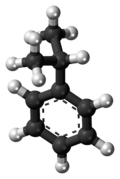كومين Cumene
|
| |||
| الأسماء | |||
|---|---|---|---|
| اسم أيوپاك المفضل
(Propan-2-yl)benzene[1] | |||
أسماء أخرى
| |||
| المُعرِّفات | |||
| رقم CAS | |||
3D model (JSmol)
|
|||
| مرجع بايلستاين | 1236613 | ||
| ChEBI | |||
| ChEMBL | |||
| ChemSpider | |||
| ECHA InfoCard | 100.002.458 | ||
| رقم EC |
| ||
| KEGG | |||
PubChem CID
|
|||
| رقم RTECS |
| ||
| UNII | |||
| UN number | 1918 | ||
CompTox Dashboard (EPA)
|
|||
| |||
| |||
| الخصائص | |||
| الصيغة الجزيئية | C9H12 | ||
| كتلة مولية | 120.19 g mol-1 | ||
| المظهر | Colorless liquid | ||
| الرائحة | Sharp, gasoline-like | ||
| الكثافة | 0.862 g cm−3, liquid | ||
| نقطة الانصهار | |||
| نقطة الغليان | |||
| قابلية الذوبان في الماء | negligible | ||
| قابلية الذوبان | soluble in acetone, ether, ethanol | ||
| ضغط البخار | 4.5 mmHg (25 °C)[2] | ||
| القابلية المغناطيسية | -89.53·10−6 cm3/mol | ||
| معامل الانكسار (nD) | 1.4915 (20 °C) | ||
| اللزوجة | 0.777 cP (21 °C) | ||
| المخاطر | |||
| خطر رئيسي | flammable | ||
| ن.م.ع. مخطط تصويري |    
| ||
| ن.م.ع. كلمة الاشارة | Warning | ||
| H226, H302, H304, H312, H314, H332, H335, H341, H412, H441 | |||
| P201, P202, P260, P261, P264, P270, P271, P273, P280, P281, P301+P312, P301+P330+P331, P302+P352, P303+P361+P353, P304+P312, P304+P340, P305+P351+P338, P308+P313, P310, P312, P321, P322, P330, P363, P405, P501 | |||
| NFPA 704 (معيـَّن النار) | |||
| نقطة الوميض | 43 °C (109 °F; 316 K) | ||
| 424 °C (795 °F; 697 K) | |||
| حدود الانفجار | 0.9-6.5% | ||
| الجرعة أو التركيز القاتل (LD, LC): | |||
LD50 (الجرعة الوسطى)
|
12750 mg/kg (oral, mouse) 1400 mg/kg (oral, rat)[4] | ||
LC50 (التركيز الأوسط)
|
200 ppm (mouse, 7 hr)[4] | ||
LCLo (المنشورة الأقل)
|
8000 ppm (rat, 4 hr)[4] | ||
| حدود التعرض الصحية بالولايات المتحدة (NIOSH): | |||
PEL (المسموح)
|
TWA 50 ppm (245 mg/m3) [skin][3] | ||
REL (الموصى به)
|
TWA 50 ppm (245 mg/m3) [skin][3] | ||
IDLH (خطر عاجل)
|
900 ppm[3] | ||
| مركبات ذا علاقة | |||
مركـّبات ذات علاقة
|
ethylbenzene toluene benzene | ||
ما لم يُذكر غير ذلك، البيانات المعطاة للمواد في حالاتهم العيارية (عند 25 °س [77 °ف]، 100 kPa). | |||
| مراجع الجدول | |||
Cumene (isopropylbenzene) is an organic compound that contains a benzene ring with an isopropyl substituent. It is a constituent of crude oil and refined fuels. It is a flammable colorless liquid that has a boiling point of 152 °C. Nearly all the cumene that is produced as a pure compound on an industrial scale is converted to cumene hydroperoxide, which is an intermediate in the synthesis of other industrially important chemicals, primarily phenol and acetone (known as the cumene process).
الانتاج
Commercial production of cumene is by Friedel–Crafts alkylation of benzene with propylene. The original route for manufacturing of cumene was by alkylation of benzene in the liquid phase using sulfuric acid as a catalyst, but because of the complicated neutralization and recycling steps required, together with corrosion problems, this process has been largely replaced. As an alternative, solid phosphoric acid (SPA) supported on alumina has been used as the catalyst.
Since the mid-1990s, commercial production has switched to zeolite-based catalysts. In this process, the efficiency of cumene production is generally 70-75%. The remaining components are primarily polyisopropyl benzenes. In 1976, an improved cumene process that uses aluminum chloride as a catalyst was developed. The overall conversion of cumene for this process can be as high as 90%.
The addition of two equivalents of propylene gives diisopropylbenzene (DIPB). Using transalkylation, DIPB is comproportionated with benzene to give cumene.[5]
Autoxidation
Depending on the conditions, autoxidation of cumene gives dicumyl peroxide or cumene hydroperoxide. Both reactions exploit the weakness of the tertiary C-H bond. The tendency of cumene to form peroxides by autoxidation poses safety concerns.[6] Tests for peroxides are routinely conducted before heating or distilling.
التطبيقات
Cumene is frequently found as an ingredient in thread locking fluids.[7][8] Cumene is also a precursor chemical to the herbicide isoproturon.[9]
انظر أيضاً
المراجع
- ^ Nomenclature of Organic Chemistry : IUPAC Recommendations and Preferred Names 2013 (Blue Book). Cambridge: The Royal Society of Chemistry. 2014. pp. 139, 597. doi:10.1039/9781849733069-FP001. ISBN 978-0-85404-182-4.
- ^ Physical and Thermodynamic Properties of Pure Chemicals Data Compilation. Washington, D.C.: Taylor and Francis. 1989.
- ^ أ ب ت NIOSH Pocket Guide to Chemical Hazards 0159
- ^ أ ب ت "Cumene". Immediately Dangerous to Life or Health Concentrations (IDLH). National Institute for Occupational Safety and Health (NIOSH).
- ^ Bipin V. Vora; Joseph A. Kocal; Paul T. Barger; Robert J. Schmidt; James A. Johnson (2003). "Alkylation". Kirk-Othmer Encyclopedia of Chemical Technology. Kirk‐Othmer Encyclopedia of Chemical Technology. doi:10.1002/0471238961.0112112508011313.a01.pub2. ISBN 0471238961.
- ^ CDC - NIOSH Pocket Guide to Chemical Hazards
- ^ "LOCTITE 242 MS TL Safety Data Sheet".
- ^ "Wurth Blue Thread Locker Safety Data Sheet" (PDF).
- ^ Unger, Thomas A. (1996). Pesticide synthesis handbook (1st ed.). Noyes Publications. p. 239.
وصلات خارجية
- Articles with hatnote templates targeting a nonexistent page
- ECHA InfoCard ID from Wikidata
- Articles containing unverified chemical infoboxes
- Chembox image size set
- Short description is different from Wikidata
- Hazardous air pollutants
- Alkylbenzenes
- C3-Benzenes
- كيماويات سلعية
- Suspected carcinogens
- IARC Group 2B carcinogens
- Isopropyl compounds



